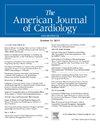无症状严重主动脉瓣狭窄的早期主动脉瓣置换术:随机对照试验的荟萃分析。
IF 2.3
3区 医学
Q2 CARDIAC & CARDIOVASCULAR SYSTEMS
引用次数: 0
摘要
确定无症状严重主动脉瓣狭窄(AS)患者左心室功能保留的最佳主动脉瓣置换术(AVR)时间仍有争议,因为目前的指南建议等到症状出现。最近的证据表明,早期AVR可能改善某些患者的预后。这项随机对照试验的荟萃分析评估了早期AVR(包括手术和经导管入路)与保守治疗对无症状严重AS的疗效。我们系统地检索了PubMed、Embase、CENTRAL和ClinicalTrials.gov,以确定符合条件的试验。关注的结局包括全因死亡率、计划外住院、中风,以及每项试验的综合终点,这是由这些结局的组合得出的。纳入了涉及1427名患者的4项试验。早期AVR显著降低计划外住院的风险(HR 0.42, 95% CI 0.33-0.53, p < 0.001, I² = 0%)。虽然有降低全因死亡率的趋势,但没有达到统计学意义(HR 0.76, 95% CI 0.48-1.21, I² = 42%)。卒中与早期AVR也有降低的趋势(HR 0.63, 95% CI 0.40-1.00, p = 0.05,I² = 0%)。总之,这些研究结果表明,早期AVR可能通过减少无症状严重AS的不良事件,特别是意外再住院,提供临床益处,这表明早期AVR可能是有益的,应该在未来的指南修订中加以考虑。本文章由计算机程序翻译,如有差异,请以英文原文为准。
Early Aortic Valve Replacement in Asymptomatic Severe Aortic Stenosis: A Meta-Analysis of Randomized Controlled Trials
Determining the best time for aortic valve replacement (AVR) in asymptomatic severe aortic stenosis (AS) with preserved left ventricular function remains controversial, as current guidelines recommend waiting until symptoms appear. Recent evidence suggests that early AVR may improve outcomes for select patients. This meta-analysis of randomized controlled trials evaluated the efficacy of early AVR, including surgical and transcatheter approaches, versus conservative management in asymptomatic severe AS. We systematically searched PubMed, Embase, CENTRAL, and ClinicalTrials.gov to identify eligible trials. The outcomes of interest included all-cause mortality, unplanned hospitalization, stroke, as well as the composite endpoint of each trial, which was derived from combinations of these outcomes. Four trials involving 1,427 patients were included. Early AVR significantly reduced the risk of unplanned hospitalizations (HR 0.42, 95% CI 0.33 to 0.53, p <0.001, I² = 0%). Although there was a trend towards reduced all-cause mortality, it did not reach statistical significance (HR 0.76, 95% CI 0.48 to 1.21, I² = 42%). Stroke also trended lower with early AVR (HR 0.63, 95% CI 0.40 to 1.00, p = 0.05, I² = 0%). In conclusion, these findings indicate that early AVR may provide clinical benefits by reducing adverse events in asymptomatic severe AS, in particular unplanned rehospitalization, suggesting that early AVR could be beneficial and should be considered in future guideline revisions.
求助全文
通过发布文献求助,成功后即可免费获取论文全文。
去求助
来源期刊

American Journal of Cardiology
医学-心血管系统
CiteScore
4.00
自引率
3.60%
发文量
698
审稿时长
33 days
期刊介绍:
Published 24 times a year, The American Journal of Cardiology® is an independent journal designed for cardiovascular disease specialists and internists with a subspecialty in cardiology throughout the world. AJC is an independent, scientific, peer-reviewed journal of original articles that focus on the practical, clinical approach to the diagnosis and treatment of cardiovascular disease. AJC has one of the fastest acceptance to publication times in Cardiology. Features report on systemic hypertension, methodology, drugs, pacing, arrhythmia, preventive cardiology, congestive heart failure, valvular heart disease, congenital heart disease, and cardiomyopathy. Also included are editorials, readers'' comments, and symposia.
 求助内容:
求助内容: 应助结果提醒方式:
应助结果提醒方式:


